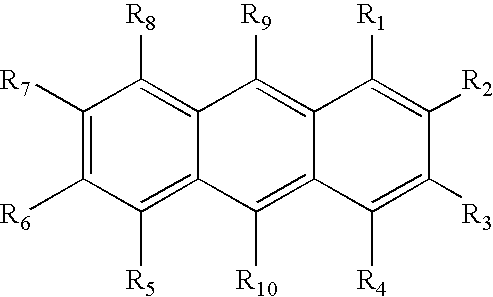Photoinitiator systems with anthracene-based electron donors for curing cationically polymerizable resins
- Summary
- Abstract
- Description
- Claims
- Application Information
AI Technical Summary
Benefits of technology
Problems solved by technology
Method used
Image
Examples
examples
Test Methods
Cure Speed and Enthalpy Test Method A
[0075] Test samples were evaluated for cure speed and enthalpy with a 2920 Differential Scanning Photocalorimeter (TA Instruments, New Castle Del.). Samples (10 mg) in open aluminum pans were exposed to low-intensity visible light (3 mW / cm2, 400-800 nm) under nitrogen gas purge and the Photocalorimeter measured the amount of heat flow necessary to maintain isothermal conditions (37° C.) as the polymerization reaction occurred. A dual sample cell was used in which two samples were run simultaneously against a cured reference sample. Induction times, reaction peak (Peakmax) times, and total reaction enthalpy were measured. Results were reported as the average of two replicates.
Cure Speed and Enthalpy Test Method B
[0076] Cure speed and enthalpy were analyzed as described in the Cure Speed and Enthalpy Test Method A, except that the sample size was 25 mg and the Photocalorimeter measured the amount of heat flow necessary to maintain...
PUM
| Property | Measurement | Unit |
|---|---|---|
| Nanoscale particle size | aaaaa | aaaaa |
| Time | aaaaa | aaaaa |
| Temperature | aaaaa | aaaaa |
Abstract
Description
Claims
Application Information
 Login to View More
Login to View More - R&D
- Intellectual Property
- Life Sciences
- Materials
- Tech Scout
- Unparalleled Data Quality
- Higher Quality Content
- 60% Fewer Hallucinations
Browse by: Latest US Patents, China's latest patents, Technical Efficacy Thesaurus, Application Domain, Technology Topic, Popular Technical Reports.
© 2025 PatSnap. All rights reserved.Legal|Privacy policy|Modern Slavery Act Transparency Statement|Sitemap|About US| Contact US: help@patsnap.com



